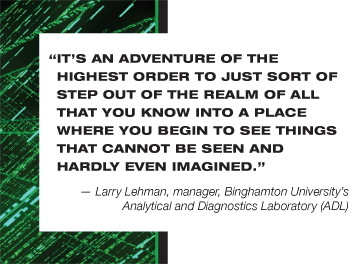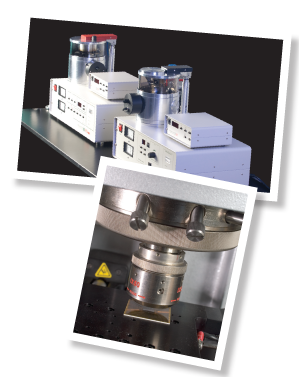page 1 | page 2

Based only on the names of equipment in the ADL, even non-scientists will recognize that there must be something big going on in a lab designed to examine things in the most minute detail. There’s the atomic force microscope, scanning electronic microscope, dual-beam focused ion beam/electron microscope, transmission electron microscope, ultra-fast laser confocal imaging system, a spectroscopic ellipsometer, a scanning acoustic microscope, an X-ray diffractometer, and small- and large-angle X-ray scattering devices. And that’s just for starters.
“What many of these tools have in common, is that they create images,” Lehman explains.
Not just any images, you understand. We’re talking images of things so small that proportionately they would be to the period at the end of this sentence what that period would be to a football field. We’re talking images at the nanometer scale, keeping in mind that a human hair is about 80,000 nanometers. We’re talking about images that look like nothing you’ve ever seen or could ever hope to see with the naked eye or even the best optical microscope, which can afford only about 1500x magnification.
In the ADL, smooth surfaces are transfigured by magnifications of up to several million times and microscopic creatures become beasts so enormous that only small portions of them can be seen at one time.
“Looking at a plain piece of paper, the topography would be like a mountain range,” Lehman said. “It would look more like an open-weave piece of cloth, and you would find it chock full of garbage, fillers of all shapes and sizes. It wouldn’t look anything like the macroscale piece of paper you’re used to seeing.”
Popular wisdom suggests that whether you’re building a house or carving a roast, whatever the job, “it’s all about having the right tools.” When it comes to research, even though Lehman offers a caveat, he agrees that having good tools is critical.
“Good research does not come from good tools; it comes from good thinking. But good tools enable you to probe the limits of good thinking,” he said. “When you get the chance to test your thinking and you say, ‘Oh this is not exactly what I thought,’ you get an opportunity to think again in a more informed way.”
And the laboratory’s flexible design will also allow investigators to rethink even their practical approach to projects.
“If scientists using the facility suddenly find themselves thinking, ‘Oh, I wish I had this tool right next to that tool,’ in this laboratory we can do that,” Lehman said. “If you want this optical microscope to sit next to that thermal tool, in 10 minutes we can make that happen.”
That’s because the laboratory was designed with all utilities in the ceiling and all equipment, tables and benches on stabilized wheels.
Depending on the type of analysis being employed in the laboratory, certain materials might be ablated and vaporize into thin air, while other substances will cling to each other in intractable crystalline cliques, refusing to mix in any proportion other than that of their own choosing. In person, it’s all pretty heady stuff, even for Lehman, who is a self-proclaimed, lifelong laboratory geek.
“It’s mind boggling to me some of the things that are possible out there in that laboratory,” Lehman said.
One of the most important roles of the ADL will be to serve as a meeting place for great minds from across the disciplines, something facilitated by the leading-edge nature of the laboratory and by the extraordinary mix of high-end equipment it houses.

“To develop products, to develop new devices, new kinds of processes, you really have to cross all the boundaries,” Lehman said. “Used to be you could go to school and take your physics courses and say, ‘I’m a physicist, and I’ll go out and I’ll study electrons or something.’
“But if you’re going to build products in the real world today, you better know a lot about a lot of things, and what’s more you better collaborate with a lot of people who are specialists at things that you are not. Because all on your own, I’m sorry, you’re probably going to be behind the curve.”
Industry faces some of the same challenges. Companies need new ideas and products, but if they are to succeed in an increasingly competitive market they can’t afford as they did in the past to invest huge sums in outright ownership of the necessary intellectual and physical infrastructure.
So the industrial research and development model has shifted, and to the degree that they can, many companies are working to improve the design of or to reduce the cost of existing technologies, without the capacity to make independent quantum leaps to next-generation products.
“They’re not making a brand new widget; they’re making the same old widget work a little better and maybe a little less expensive to produce,” Lehman said. “And you can go quite a ways doing that sort of thing. But if you want to invent a really new widget or do something in a completely different way, that’s going to take a bit more work.”
The ADL will allow even small companies to compete with big companies when it comes to next generation, high-tech widgets.
Say that a small company builds a good product and wants to move into a higher-end market with its product, Lehman proposes.
“Suddenly they’re being asked to guarantee the quality of their product at a higher level. Well, generally you can’t do that without a lot of knowledge about the internal workings of your manufacturing process and the product itself. And generally you can’t do that without good analytical tools to actually find out what’s going on. Yes, you have a product or process and it seems fine. But how fine is it? How close are we to the edge of failure?
“It’s not the same thing when you build a cheap product for short-term use and one in 10 fails. Then people will throw that one in the trash, no big deal. But when you’re building for a high-end application and the customer comes to you and says, ‘I want you to guarantee that no more than one in 10,000 of these things fails, and if it does you’re going to pay for the repair costs,’ now that’s a different ball game. Now you’re talking about, ‘I really have to know what it takes to fail. I’ve got to really know how close my manufacturing brings me to that point.”
Having access to the ADL tools and the expertise of University scientists to analyze and diagnose materials and systems will even the playing field for companies, better the chances for success in product design and hasten the process of developing new and better materials. But perhaps just as important, it will help researchers bent on believing impossible things, whether before breakfast or otherwise.
“It’s an adventure of the highest order,” Lehman said, “to just sort of step out of the realm of all that you know into a place where you begin to see things that cannot be seen and hardly even imagined.”
— Susan E. Barker
page 1 | page 2